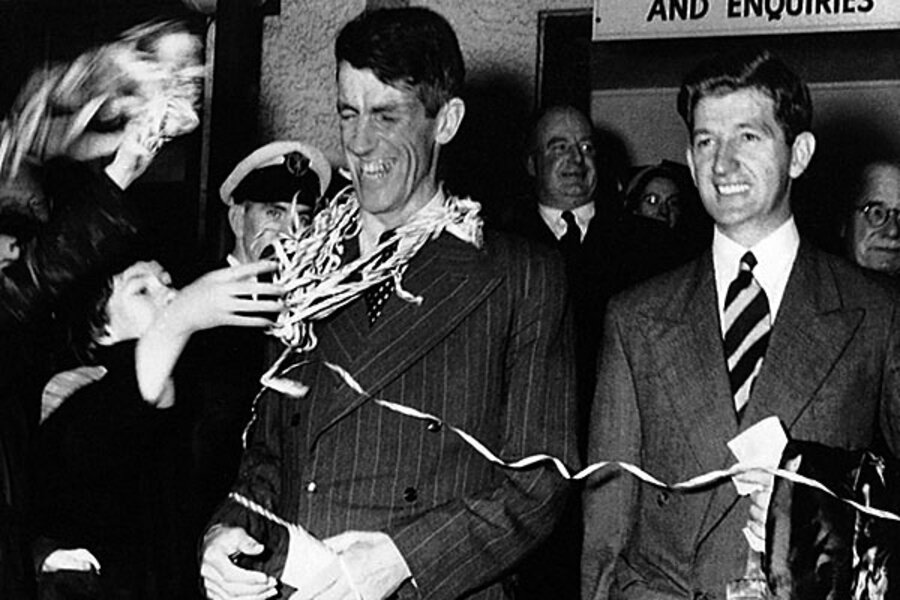George Lowe, legendary Everest mountaineer, dies
Loading...
| London
George Lowe, the last surviving climber from the team that made the first successful ascent of Mount Everest, has died at age 89.
Mary Lowe said Thursday her husband died a day earlier at a nursing home in Ripley, central England, after an illness.
Lowe and his friend Edmund Hillary were the only New Zealanders on the 1953 British-led attempt to climb the world's highest peak.
Lowe was part of a small group that established the final camp 1,000 feet (300 meters) below the mountain's summit on May 28, 1953. The next day, Hillary and Tenzing Norgay of Nepal reached the 29,035 foot (8,850 meter) peak.
As Hillary descended the next day, he met Lowe, walking toward him with soup and emergency oxygen. "Well, George," Hillary recalled saying, "we knocked the bastard off."
"He and Hillary climbed together through life, really," said travel writer Jan Morris, who was part of the Everest expedition as a journalist for The Times newspaper.
"And when it came to the point near the summit, George had to play a subsidiary role. He climbed very high, he climbed to top camp and said goodbye to Hillary then helped him come down. He played a very important role."
New Zealand Prime Minister John Key said Lowe and Hillary made New Zealand a household name when they conquered Everest 60 years ago.
"I was sad to hear of his death but remain very proud of these men's achievements," Key said in a statement.
Almost 4,000 people have now successfully climbed Everest, according to the Nepal Mountaineering Association, but that 1953 expedition remains one of the iconic moments of 20th-century adventure.
Morris said she was now the only survivor of the 1953 group.
She said Lowe was "a gentleman in the old sense — very kind, very forceful, thoughtful and also a true adventurer, an unusual combination."
Hillary, who died in 2008, inevitably got much of the media attention — and a knighthood from Queen Elizabeth II. Mary Lowe said her husband "didn't mind a bit."
"He had a wonderful life," she said. "He did a lot of things, but he was a very modest man and he kept quiet about it.
"He never sought the limelight. Ed Hillary didn't seek the limelight either — but he had it thrust upon him."
Born in Hastings, New Zealand, in 1924 and a teacher by training, Lowe began climbing in the country's Southern Alps and met Hillary, another ambitious young climber with whom he forged a lifelong bond.
In 1951, he was part of a New Zealand expedition to the Himalayas, and in 1953 he and Hillary joined the British Everest expedition led by John Hunt.
Kari Herbert of Polarworld, which is due to publish Lowe's book "Letters From Everest" later this year, said Lowe's efforts had been crucial to the expedition's success.
"He was one of the lead climbers, forging the route up Everest's Lhotse Face without oxygen and later cutting steps for his partners up the summit ridge," she said.
Lowe directed a film of the expedition, "The Conquest of Everest," which received an Academy Award nomination in 1954 for best documentary feature.
He also made "Antarctic Crossing" after participating in the 1955-58 Commonwealth Trans-Antarctic Expedition, the first successful overland crossing of the continent. It, too, was Oscar-nominated.
Lowe later made expeditions to Greenland, Greece and Ethiopia, taught school in Britain and Chile, lectured on his expeditions and became Her Majesty's Inspector of Schools for England.
He was a founder of the Sir Edmund Hillary Himalayan Trust U.K., a charity set up to support the mountain residents of Nepal.
Lowe is survived by Mary and by three sons from his first marriage to John Hunt's daughter Susan: Gavin, Bruce and Matthew.
Mary Lowe said a memorial service would be held next month.
___
Associated Press writers Gregory Katz in London and Nick Perry in Wellington, New Zealand, contributed to this report.
Copyright 2013 The Associated Press.







